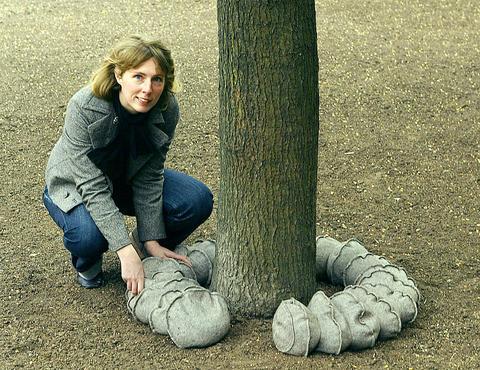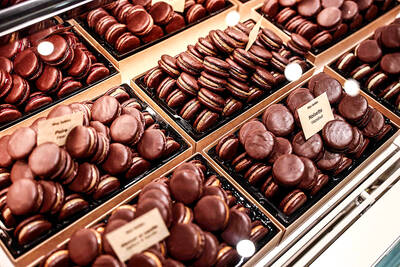An environmentally friendly method of burying the dead is offering stiff competition to traditional funerals, transforming corpses into organic compost and giving people the chance to come back as flowers.
Six-feet-under burials and cremations hurt the environment by polluting air and water, and upset the ecology of the sea, prompting Swedish biologist Susanne Wiigh to come up with an alternative.

PHOTO:AFP
"Nature's original plan was for dead bodies to fall on the earth, be torn apart by animals, and become soil," Wiigh said in Lyr, a small romantic island off Sweden's southwestern coast, where she lives with her family and runs her company, Promessa AB.
Wiigh, who also manages the island's only shop well-stocked with organic food next to an impressive greenhouse, acknowledges that "we clearly can't go back to that," but claims that her method is as close to nature as modern ethics will allow.
The method is chilling: It consists of taking the corpse's temperature to minus 1960 C in a liquid nitrogen bath and breaking the brittle body down into a rough powder through mechanical vibrations.
The remains are then dehydrated and cleared of any metal, reducing a body weighing 75kg in life to 25kg of pink-beige powder, plus the remains of the coffin.
The whole process takes place in a facility resembling a crematorium and lasts for about two hours.
A corpse buried in a coffin will take several years to decompose completely.
Wiigh says compost has always been her passion. "For me it's really romantic. It smells good, it feels like gold," she said.
And like all compost, human remains should be used to feed plants and shrubs, planted by a dead person's family, and would disappear completely into the plant within a few years, she believes.
"The plant becomes the perfect way to remember the person. When a father dies, we can say: the same molecules that built Daddy also built this plant" said Wiigh, whose dead cat, Tussan, currently nourishes a rhododendron bush in her front garden.
Wiigh herself, a quiet-spoken woman with an easy smile who dedicates 60 hours a week to Promessa, would herself also like to turn into a rhododendron, of the white variety.
What may look like no more than an ecologist's dream vision may well have serious business potential, breathing new life into an innovation-shy industry, which seems almost as inanimate as its customers.
Industrial gases company AGA Gas, part of Germany's Linde group, has invested in the idea, taking a controlling stake of 53 percent in Promessa, alongside Wiigh's 42 percent and 5 percent which is held by the Church of Sweden.
"The commercial potential could be quite large," said AGA spokesman Olof Kaellgren, whose company contributes expertise of the nitrogen cooling process.
But he stressed that AGA considers the new method to be "a complement to already existing methods and therefore giving a new opportunity to make a choice that for many people feels better than today's alternative."
The city of Joenkoeping, in southwestern Sweden, has already decided that it will not replace its outdated crematorium, instead becoming the first customer of Promessa.
The installation, which will be cheaper than the 2 million euro (US$2.4 million) price tag for a new crematorium, is to be ready next year.
Promessa has applied for patents in 35 countries. Its immediate foreign markets are in ecology-conscious Northern Europe and include Scandinavia, Britain, Germany and the Netherlands, where the next installation is likely to be built.
But queries have come from as far away as South Africa, where the soil often lacks the depth needed for ordinary burials.
There may also be sales potential in countries where religion makes cremation difficult or impossible, such as Muslim countries.
And Swedish designers have been stirred into action by the new method, focusing their attention on making containers which are smaller than traditional coffins, but larger than ash urns, and biodegradable.
Stockholm design graduate Linda Jaerned has made two prototypes for those who would like their freeze-dried remains to be buried in a container, rather than just mixed with soil.
One is a soft tube made of felt, resembling a paper dragon in a Chinese New Year parade, while the other is a more traditional-looking box made of plywood and linen.
"I think this is the future. We don't have so much space for the dead. The living will take more and more space," said Jaerned.

Many people noticed the flood of pro-China propaganda across a number of venues in recent weeks that looks like a coordinated assault on US Taiwan policy. It does look like an effort intended to influence the US before the meeting between US President Donald Trump and Chinese dictator Xi Jinping (習近平) over the weekend. Jennifer Kavanagh’s piece in the New York Times in September appears to be the opening strike of the current campaign. She followed up last week in the Lowy Interpreter, blaming the US for causing the PRC to escalate in the Philippines and Taiwan, saying that as

This year’s Miss Universe in Thailand has been marred by ugly drama, with allegations of an insult to a beauty queen’s intellect, a walkout by pageant contestants and a tearful tantrum by the host. More than 120 women from across the world have gathered in Thailand, vying to be crowned Miss Universe in a contest considered one of the “big four” of global beauty pageants. But the runup has been dominated by the off-stage antics of the coiffed contestants and their Thai hosts, escalating into a feminist firestorm drawing the attention of Mexico’s president. On Tuesday, Mexican delegate Fatima Bosch staged a

Taiwan can often feel woefully behind on global trends, from fashion to food, and influences can sometimes feel like the last on the metaphorical bandwagon. In the West, suddenly every burger is being smashed and honey has become “hot” and we’re all drinking orange wine. But it took a good while for a smash burger in Taipei to come across my radar. For the uninitiated, a smash burger is, well, a normal burger patty but smashed flat. Originally, I didn’t understand. Surely the best part of a burger is the thick patty with all the juiciness of the beef, the

Would you eat lab-grown chocolate? I requested a sample from California Cultured, a Sacramento-based company. Its chocolate, not yet commercially available, is made with techniques that have previously been used to synthesize other bioactive products like certain plant-derived pharmaceuticals for commercial sale. A few days later, it arrives. The morsel, barely bigger than a coffee bean, is supposed to be the flavor equivalent of a 70 percent to 80 percent dark chocolate. I tear open its sealed packet and a chocolatey aroma escapes — so far, so good. I pop it in my mouth. Slightly waxy and distinctly bitter, it boasts those bright,